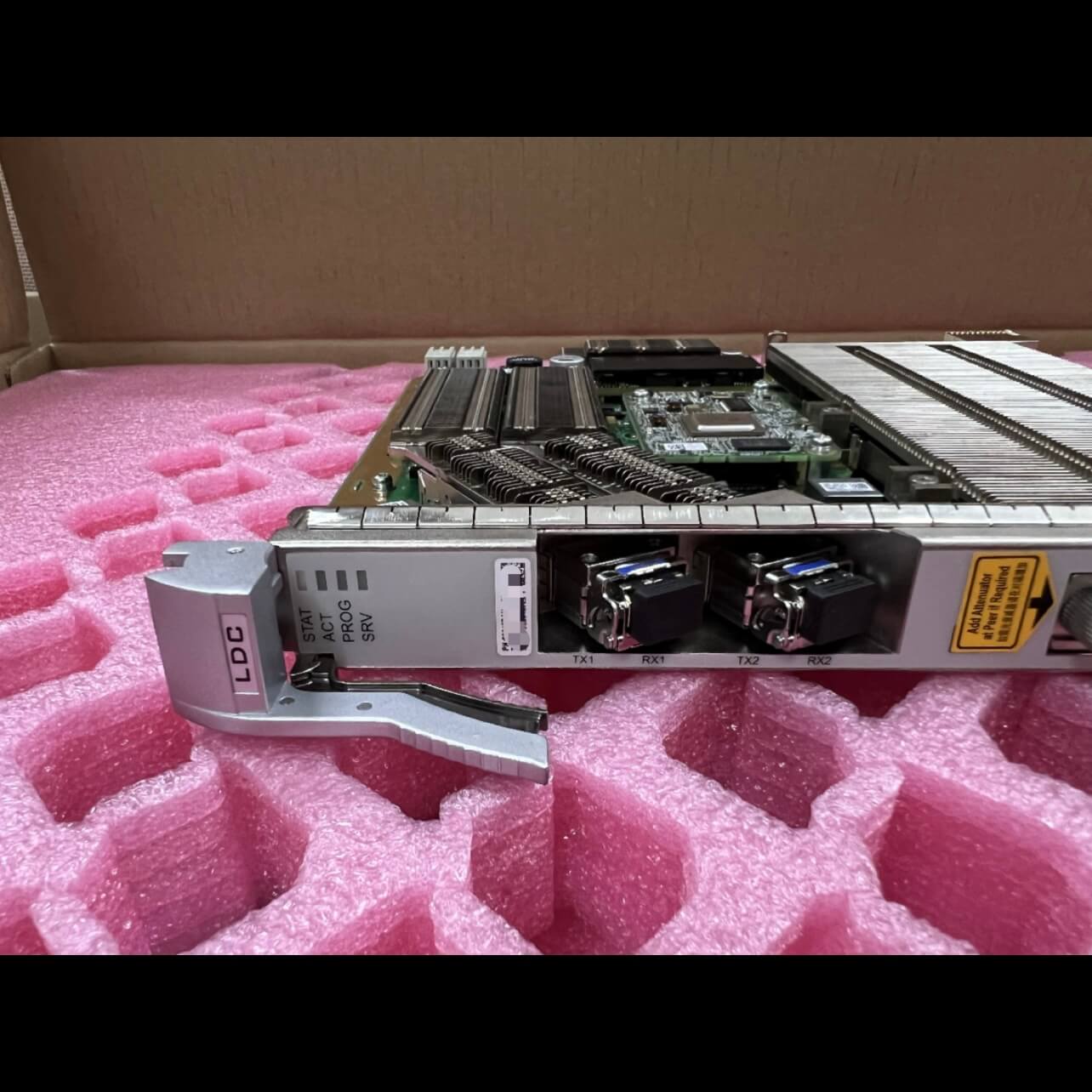Link You To Professional Networks

TMB1LDC Is Huawei OptiXtrans E6600 2 Port 100G Service Convergence Wavelength Conversion Board

Huawei OptiXtrans E6600 2 Port 100G Service Convergence Wavelength Conversion Board TMB1LDC Overview
TMB1LDC: 2-channel 100Gbit/s to 1-Channel OTUC2/OTU4 Service Convergence Wavelength Conversion Board
The available functional version of the LDC board is TN11/TN12.
The LDC board is a wavelength conversion board and applies to coherent systems. In the receive direction, the LDC board receives four types of signals on the client side, which are OTU4, 100GE, FC3200 and FC1600, maps these optical signals into an OTUC2 or OTU4 signal, and converts the OTUC2 or OTU4 signal into a standard WDM wavelength.
The LDC board is mainly used to achieve wavelength tunable and to provide OTN interfaces and ESC.
The LDC board consists of the client-side optical module, WDM-side optical module, signal processing module, control and communication module, and power supply module.
Functions and Features of the TMB1LDC Board
|
Function and Feature |
Description |
|
Basic function |
The LDC board on the client side receives four types of signals, which are OTU4, 100GE, FC3200, and FC1600. The LDC converts signals as follows: 200G line:
100G line:
|
|
Client-side service type |
100GE: Ethernet service at a rate of 103.125 Gbit/s OTU4: OTN service at a rate of 111.81 Gbit/s FC1600: SAN service at a rate of 14.025 Gbit/s FC3200: SAN service at a rate of 28.05 Gbit/s |
|
RTU |
Supported only by TN12LDC. |
|
OTN function |
|
|
Service encryption |
Supported NOTE: Service encryption is supported only when the client-side service type of the LDC board is not OTU4. |
|
WDM specification |
Supports DWDM specifications. |
|
Tunable wavelength function |
LDC supports tunable wavelength optical modules that provide for 96 wavelengths tunable in the extended C band with 50 GHz channel spacing. |
|
WDM-side signal spectrum width |
NOTE: The filter cost of a 50 GHz Fix WSS is greater than that of a 50 GHz Flex WSS. If the board has a flexible grid laser and supports a modulation format with 50 GHz fixed spectrum width, the modulation format supports 50 GHz flexible spectrum width by default. Similarly, if the board has a flexible grid laser and supports a modulation format with 100 GHz fixed spectrum width, the modulation format supports 100 GHz flexible spectrum width by default. Currently, only programmable boards with a signal rate of 200 Gbit/s or higher support flexible grid lasers. |
|
ESC function |
Supported |
|
PRBS test function |
Supports the PRBS function on both the client side and WDM side. NOTE: When only OTU4 services are received, the PRBS function is supported on the client side. |
|
LPT function |
Not supported |
|
FEC coding |
On the client side: Supports ITU-T G.709-compliant forward error correction (FEC) on the client side when the client-side service type is OTU4. Supports RS_FEC coding when the client-side service type is 100GE or FC3200. On the WDM side: T81: Supports SDFEC-R coding. Others: Supports SDFEC and SDFEC2 coding. NOTE: Boards that use different FEC modes cannot interconnect with each other. NOTE: For FC services, only FC3200 services support RSFEC, and other FC services do not support FEC. |
|
Alarm and performance event monitoring |
Monitors BIP8 bytes (BIP8 bytes of OTU4 are in Bursty mode) for 100GE, and OTU4 services on the client side to help locate service failures.
Supports the remote monitoring (RMON) of Ethernet services.
|
|
Regeneration board |
Supported |
|
ALS function |
Supports the ALS function on the client side when client services are non-OTN services. |
|
Test frame |
Supported only when the client-side service type is 100GE. |
|
Latency measurement |
Supports PM and TCM latency measurement. Supports PM and TCM latency measurement for upstream higher-order ODU channels. Supports PM and TCM latency measurement for upstream lower-order ODU channels when non-OTN services are received on the client side. Supports TCM latency measurement for downstream lower-order ODU channels when OTN services are received on the client side. NOTE: In a mapping path, the maximum granularity ODUk channel is the higher-order ODU channel, and other ODUk channels are lower-order ODUk channels. |
|
IEEE 1588v2 |
Not supported |
|
Physical clock |
The board supports synchronous Ethernet transparent transmission instead of synchronous Ethernet processing in bit transparent mapping mode. |
|
Electrical-layer ASON |
Not supported |
|
Optical-layer ASON |
Supported NOTE: In versions earlier than V100R013C10SPC500, ASON is not supported in high SOP mode. In V100R013C10SPC500 and later versions, only ASON without optical parameters is supported in high SOP mode. |
|
Ethernet service mapping mode |
Bit Transparent Mapping ODU4, MAC Transparent Mapping ODU4, MAC Transparent Mapping ODUFlex |
|
Protection scheme |
|


